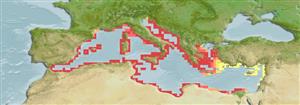Common names from other countries
Environment: milieu / climate zone / depth range / distribution range
Ecologia
; intervalo de profundidade 1 - 10 m (Ref. 363). Subtropical
Endemic to the Mediterranean.
Length at first maturity / Tamanho / Peso / Idade
Maturity: Lm ? range ? - ? cm Max length : 12.0 cm WD macho/indeterminado; (Ref. 358)
Diameter of the pedal disc: 7 cm; diameter of the oral disc, without the tentacles: 12 cm maximum; 30 cm with its tentacles 96; laid out in 5 crowns around the oral siphon; and measuring approximately 8 cm; thick, they are completed in a round point. Oral disc comprising of the reasons for varied color: gray with nuances white; yellow; green or brown; also gray tentacles with nuances of white; yellow or brown; and with point violet; one the lower third of the foot; as for him, is red orange and counts 12 longitudinal bands of a tinted dirty white of yellow; partially discontinuous (Ref. 358).
Always inserted in the sandy or gravelly funds; the free foot in its substrate and the oral disc as well as the tentacles flat on the surface. Common of the small funds (Ref. 358). Sandy Funds from 1 to 10 m (Ref. 363). Known from infralittoral zones (Ref. 85338). Solitary (Ref. 2377).
Life cycle and mating behavior
Maturidade | Reprodução | Desova | Ovos | Fecundidade | Larvas
Members of the class Anthozoa are either gonochoric or hermaphroditic. Mature gametes are shed into the coelenteron and spawned through the mouth. Life cycle: The zygote develops into a planktonic planula larva. Metamorphosis begins with early morphogenesis of tentacles, septa and pharynx before larval settlement on the aboral end.
Göthel, H. 1992. (Ref. 358)
Status na Lista Vermelha da IUCN (Ref. 130435)
Status no CITES (Ref. 108899)
Not Evaluated
Not Evaluated
Uso pelos humanos
| FishSource |
Ferramentas
Mais informação
Idade/TamanhoCrescimentoComprimento-pesoComprimento-comprimentoMorfologiaLarvasAbundância
Fontes da internet
Estimates based on models
Preferred temperature
(Ref.
115969): 17.6 - 21.8, mean 19.2 (based on 431 cells).
Vulnerabilidade
Low vulnerability (10 of 100).
Categoria de preço
Unknown.
